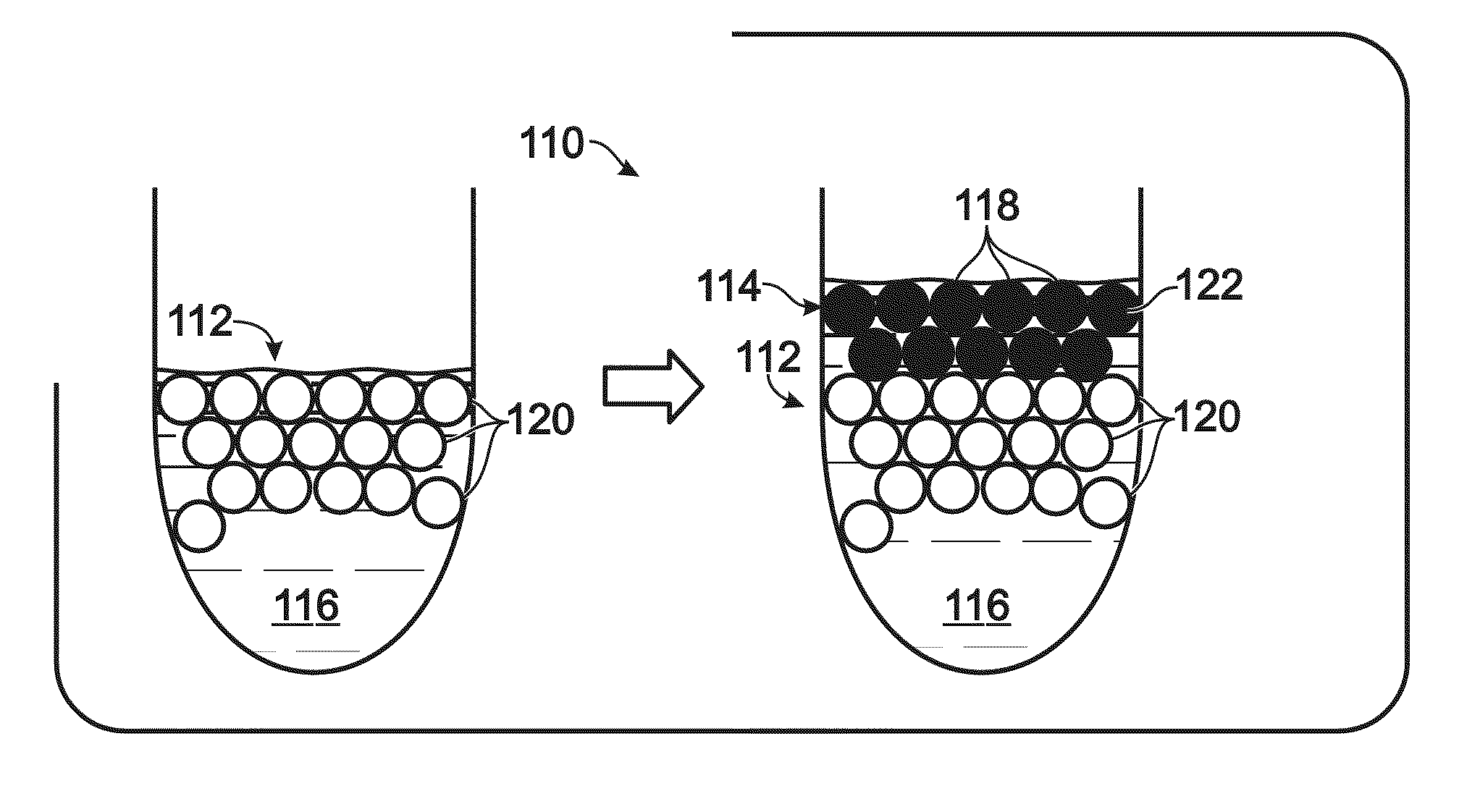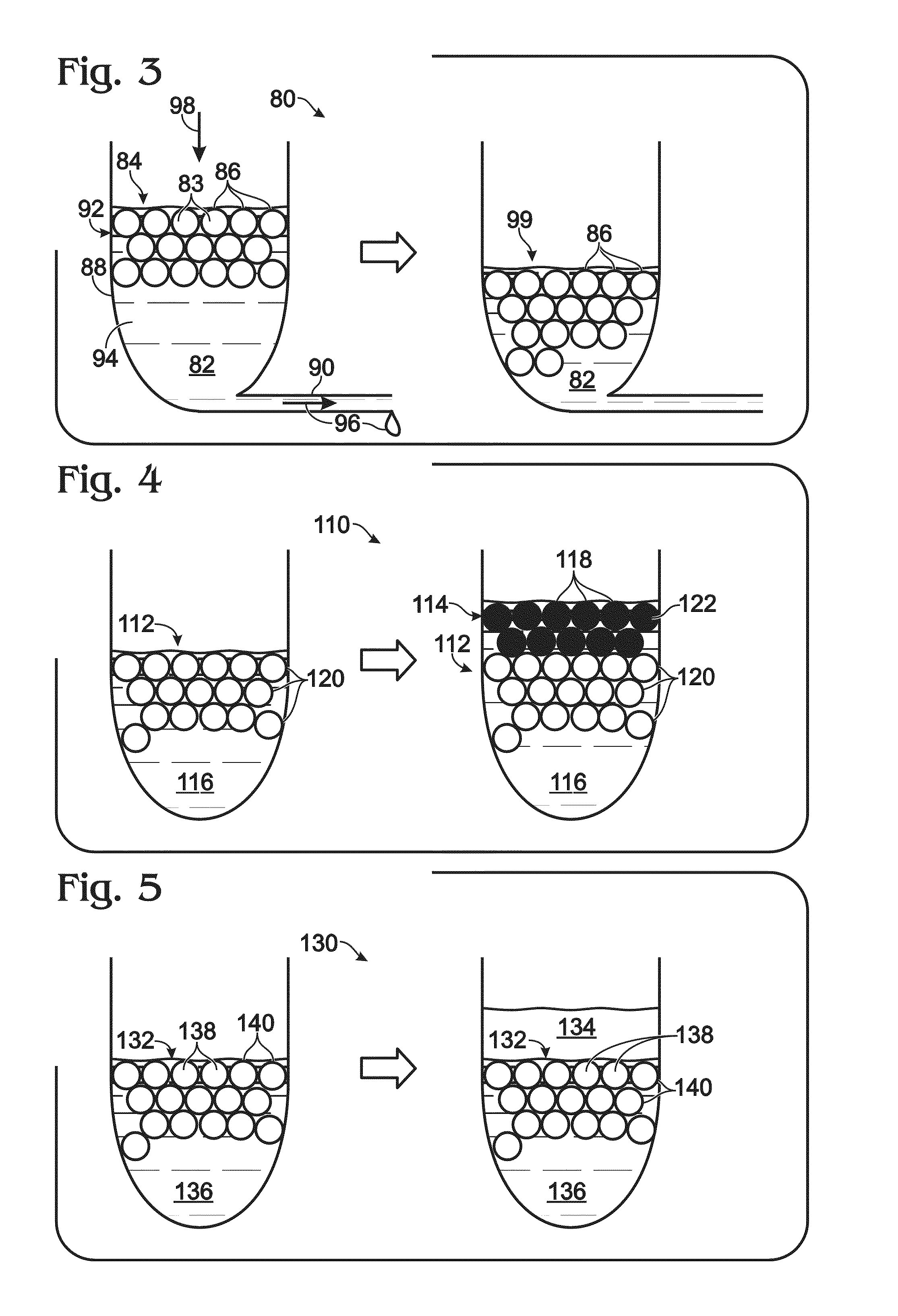Assays with droplets transformed into capsules
a droplet and capsule technology, applied in the field of capsule transformation assays, can solve the problems of limiting the ability to store droplets, emulsion instability, and difficulty in maintaining the integrity of droplets
- Summary
- Abstract
- Description
- Claims
- Application Information
AI Technical Summary
Benefits of technology
Problems solved by technology
Method used
Image
Examples
example 1
Selective Removal of Continuous Phase from an Emulsion
[0166]This example describes an exemplary approach 80 to removing a continuous phase 82 selectively (relative to a dispersed phase 83) from an emulsion 84, to increase the volume fraction occupied by droplets (or capsules) 86; see FIG. 3.
[0167]Emulsion 84 may be held by a reservoir 88 having a port 90. The port may be formed near or at the bottom of the reservoir, if droplets 86 are buoyant in the continuous phase (as shown here), or may be formed at a higher position of the reservoir if the droplets sink in the continuous phase.
[0168]Buoyant droplets may move within the continuous phase over time toward the top of the emulsion, in a process termed creaming, if the droplets initially have a more uniform distribution in the entire volume of the continuous phase. As a result, the droplets accumulate over time in an upper region of the continuous phase, to form a droplet layer 92 of aggregated droplets that grows downward as buoyant...
example 2
Overlaying an Emulsion
[0169]This example describes exemplary approaches to overlaying an emulsion with liquid; see FIGS. 4 and 5. The use of an overlay may be suited for use with an emulsion having buoyant droplets. In this case, buoyancy causes droplets to collect near the interface of the emulsion with air, which renders the droplets less protected by the continuous phase and more vulnerable to evaporative loss. Also, the presence of an air interface may render the emulsion more susceptible to heat-induced damage to droplets (e.g., droplet breakage).
[0170]FIG. 4 illustrates an approach 110 to overlaying an emulsion 112 by using an overlay emulsion 114. The overlay emulsion may or may not have substantially the same continuous phase 116 as underlying or primary emulsion 112, but generally has a continuous phase that is miscible with the continuous phase of the primary emulsion. The overlay emulsion may include aqueous overlay droplets 118 that are distinguishable from droplets 120 ...
example 3
Spacing Fluids and Capsule Damage
[0176]This example describes exemplary spacing fluids with distinct effects on capsule shape and integrity, and presents micrographs showing these effects; see FIGS. 6A, 6B, and 7A-D.
[0177]FIGS. 6A and 6B show a pair of micrographs of capsules from emulsions that have been exposed to a spacing fluid composed of a base oil without surfactant (FIG. 6A) or with surfactant (FIG. 6B). Droplets were generated in HFE 7500 fluorinated oil with 1.8% w / w of Krytox-AS as surfactant. Excess continuous phase was removed, and then the droplets were heated to form capsules. A spacing fluid was added to the continuous phase, which substantially increased the volume fraction of the continuous phase in the emulsion. The spacing fluid was either base oil (HFE 7500) without surfactant (FIG. 6A) or with surfactant at the same concentration as for droplet generation (1.8% w / w of Krytox-AS). In other words, the spacing fluid had the same composition as the original continu...
PUM
| Property | Measurement | Unit |
|---|---|---|
| temperature | aaaaa | aaaaa |
| temperature | aaaaa | aaaaa |
| diameter | aaaaa | aaaaa |
Abstract
Description
Claims
Application Information
 Login to View More
Login to View More - R&D
- Intellectual Property
- Life Sciences
- Materials
- Tech Scout
- Unparalleled Data Quality
- Higher Quality Content
- 60% Fewer Hallucinations
Browse by: Latest US Patents, China's latest patents, Technical Efficacy Thesaurus, Application Domain, Technology Topic, Popular Technical Reports.
© 2025 PatSnap. All rights reserved.Legal|Privacy policy|Modern Slavery Act Transparency Statement|Sitemap|About US| Contact US: help@patsnap.com



